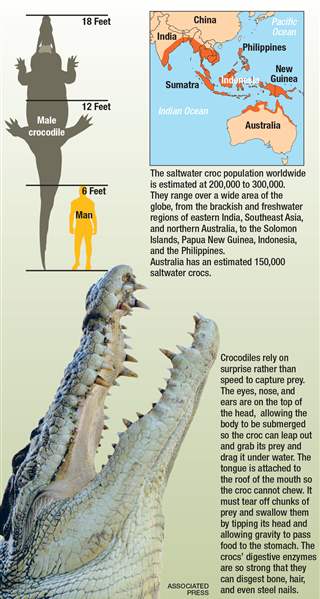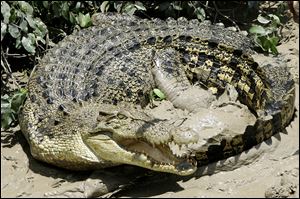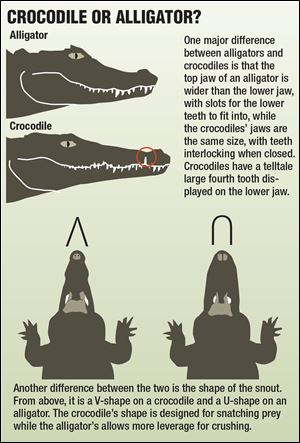
TOLEDO MAGAZINE
Saltwater Crocs: Largest Reptiles on Earth
5/27/2013
Infographic on crocodiles around the world
THE BLADE
Buy This Image

A saltwater crocodile on the bank of the Adelaide river in Australia.

Infographic on crocodiles around the world
If Baru, the Toledo Zoo’s toothy new celebrity crocodilian, were to trace his lineage, the trip would take him back a few million years, and then maybe a couple hundred million more. There is strong evidence that crocodiles were here on Earth well before the dinosaurs, and crocs survived the mass extinction some 65 million years ago that wiped out the dinosaurs.
“They are a link to the past for the world,” said Andy Odum, curator of herpetology at the zoo. “They managed to survive that great disaster when most other species did not.”
The saltwater crocodile is the largest living reptile, and a very efficient predator at the top of the food chain. “Crocs are nature’s perfect little submarines,” Mr. Odum said. “They have those second eyelids that act like underwater goggles, and they are extremely powerful when they attack their prey.”
Although they carry the “saltwater” tag and can live for long periods in saltwater, most of these crocs spend the majority of their time in freshwater systems. Some will live 100 percent of their lives in freshwater.
“Calling them an estuarine croc is probably more descriptive,” Mr. Odum said.
DOWNLOAD THE PAGE: Toledo Magazine: Saltwater crocodiles
One class of male crocs displays high “site fidelity” and is dominant enough to rule an area. With his size and strength, Baru would fall into that group. The smaller subservient males travel long distances just to avoid the big boys.
“They are highly socialized animals, but that doesn’t mean they are friendly,” Mr. Odum said. “The adult males are extremely territorial, and will battle to the point of killing each other.”
The females spend most of their time in the territory of a dominant male, but will venture considerable distances, as much as 30 miles, to find a suitable nesting area.
“They want more than just a nest,” Mr. Odum said. “They want a place to raise their young, something very much like a rookery.”
Less than 1 percent of the crocodile hatchlings will reach adult maturity, which is about 16 years for males and 10 years for females. Young crocodiles are heavily preyed on by turtles, territorial male crocs, and Australian monitor lizards, while croc eggs are preyed on by birds.
Mature saltwater crocs are opportunistic feeders, with a good memory. One group of crocs in Southeast Asia will swim a long distance at the same time each year to reach islands where they de-shell and eat sea turtles that have gathered there. Saltwater crocs also patiently bide their time in the arid north of Australia, and when the billabongs dry up, the crocs gorge themselves on the fish trapped in these isolated ponds.
Their metabolism allows these crocs to eat infrequently and still thrive.
“It has been very enlightening having Baru here,” Mr. Odum said. “We have learned a lot about crocodilian behavior in the little time that he has been at the zoo. These are truly fascinating creatures.”

Infographic on the difference between crocodiles and alligators.
■ Saltwater crocodile, Crocodylus porosus